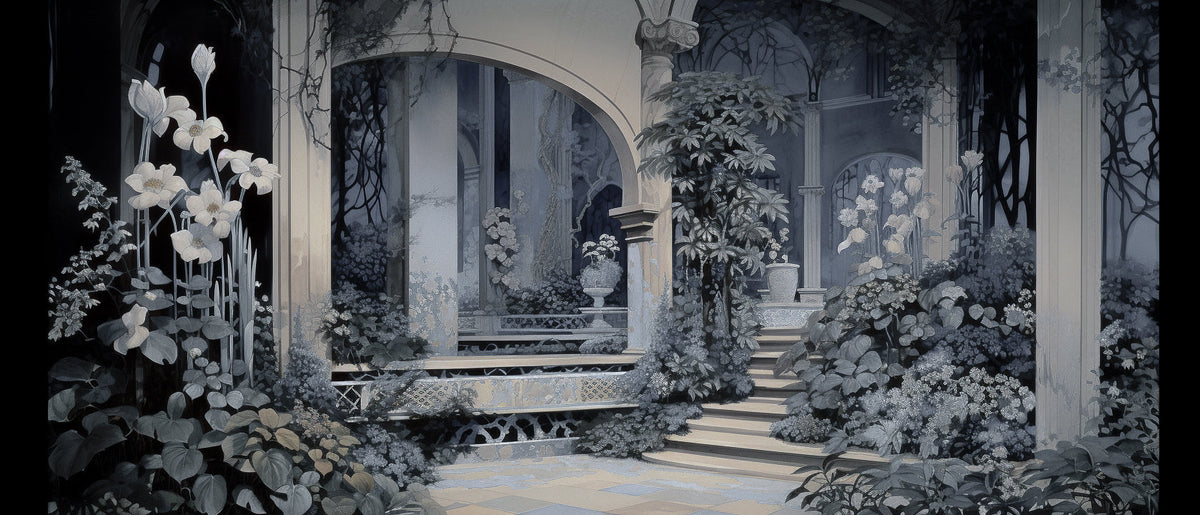
Shadows in the Parterre: The Fragrant Whispers of East and West
|
|
Time to read 9 min


|
|
Time to read 9 min
As twilight descends over a moony garden in North India, imagine a perfumer silently working among narcissus blooms, capturing their essence for a creation that would delight nobility. This scene, far from fictional, represents the sophisticated natural perfume traditions that flourished in the Mughal courts of the 16th and 17th centuries.
The Mughals elevated natural fragrance perfume to an art form intrinsically connected to their elaborate gardens. These weren’t merely pleasant spaces but carefully designed sensory experiences where the visual beauty of geometric patterns complemented the olfactory delight of strategically planted aromatics. The creation of an all natural perfume was considered both an art and a science in these ancient civilizations, with techniques passed down through generations of skilled artisans.
In this era, perfumers were often poets and scholars who understood the language of scent as intimately as they knew literature. They created what we might now recognize as the first niche fragrance traditions – exclusive, artisanal creations made for discerning patrons who understood their cultural significance. The ingredients used in natural perfumes often reflected the local botanical landscape and garden traditions, creating a direct link between environment and olfactory expression.
The Mughal emperor Jahangir himself was known to appreciate the best natural perfumes, often commissioning special blends for significant occasions. These weren’t simply pleasant smells but complex compositions that told stories and conveyed status. Historical records show that natural perfume for men was common in both Eastern and Western royal courts, challenging our modern notions of gendered fragrances.
The tradition of natural perfume making spans centuries and crosses cultural boundaries from East to West. In both regions, gardens served as living laboratories for perfumers and powerful symbols of status and control. The ability to cultivate rare botanicals and transform them into exquisite scents demonstrated both wealth and cultural sophistication.
In Mughal India, the chahar bagh (four-part garden) design reflected cosmic order and paradise on earth. These weren’t merely decorative spaces but expressions of power – the ruler who could command water in arid regions and grow exotic plants demonstrated mastery over nature itself. Similarly, the ingredients that went into natural perfumes became political statements, with rare botanicals from distant lands showcasing trade connections and imperial reach.
The connection between gardens and natural fragrance perfume creation is evident across cultures and time periods. Garden designs often incorporated aromatic plants not just for their beauty but for their scent profiles. Jasmine, rose, narcissus, and other fragrant blooms were cultivated specifically for perfumery, creating a direct pipeline from garden to scent creation.
Throughout history, natural perfumes have been symbols of status and cultural refinement. The most precious blends often contained ingredients from across known trade routes – frankincense from Arabia, sandalwood from India, and precious florals from carefully tended royal gardens. The best natural perfumes were historically reserved for royalty and nobility across cultures, their recipes guarded as valuable secrets.
As we travel westward to France, we discover how European garden traditions and perfumery evolved in conversation with Eastern influences. The evolution of niche fragrance in France represents one of history’s most fascinating cultural exchanges, with techniques and aesthetics flowing between East and West along trade routes.
The formal gardens of Versailles under Louis XIV weren’t merely decorative but powerful political statements. Like their Mughal counterparts, these gardens demonstrated control over nature and showcased exotic botanicals from around the world. The Sun King understood that dominating the senses – including smell – was essential to projecting power.
French perfumery flourished in this environment, with the town of Grasse eventually becoming the world center for natural perfume production. The art of creating a niche fragrance often involves drawing inspiration from historical garden designs and botanical elements, a tradition that began in earnest during this period. Perfumers worked closely with gardeners to ensure a steady supply of aromatic materials, creating a direct link between landscape design and scent creation.
The concept of the best niche fragrance for women has evolved alongside changing cultural norms. In Louis XIV’s court, heavy floral compositions signaled wealth and status, while later periods saw lighter, more nuanced creations come into favor. Throughout these changes, the fundamental connection between garden aesthetics and perfume composition remained constant.
Artisans who specialize in natural fragrance perfume often study historical texts to inform their craft. Many techniques used in modern natural perfume making – enfleurage, distillation, and maceration – were refined during this period of intense cultural exchange between East and West. The modern revival of all natural perfume making draws heavily on these historical techniques and recipes.
As garden aesthetics evolved from formal geometric designs to more naturalistic landscapes, perfumery followed suit. The 18th century brought the picturesque garden movement, which rejected rigid formality in favor of designs that appeared more natural and spontaneous. This shift reflected changing philosophical ideas about humanity’s relationship with nature.
This transformation in landscape design paralleled changes in perfumery. Where once heavy, concentrated blends dominated, lighter compositions that celebrated the natural character of botanical ingredients gained favor. Understanding how to choose natural perfume begins with knowledge of how different botanical notes interact, a principle that became increasingly important during this period of aesthetic evolution.
The use of vanilla in natural perfume dates back to ancient Mesoamerican civilizations, but it was during this period of increased global trade that it became more widely available to Western perfumers. Other exotic materials like ambergris, musk, and tropical florals expanded the perfumer’s palette, allowing for more complex and nuanced creations.
The ingredients used in natural perfumes often reflected the local botanical landscape and garden traditions. English garden designers incorporated aromatic herbs and flowering shrubs, creating landscapes that appealed to multiple senses. These gardens weren’t merely visual experiences but immersive sensory environments where scent played a crucial role.
As wealth accumulated in America during the Gilded Age, newly minted industrialists looked to European traditions to establish their cultural credentials. American garden design drew heavily from French and English precedents, with wealthy families importing not just design concepts but often the designers themselves.
This cultural aspiration extended to perfumery as well. American elites embraced French fragrance traditions, helping to establish niche fragrance as a marker of sophistication and worldliness. The best natural perfumes often tell a story through their carefully selected botanical ingredients, a narrative that resonated with Americans eager to connect themselves to European cultural traditions.
American landscape architects like Frederick Law Olmsted created public and private gardens that incorporated aromatic plants, continuing the centuries-old tradition of designing spaces that engaged all the senses. These weren’t merely visual compositions but multisensory environments where scent played a crucial role in the overall experience.
Today’s niche fragrance market continues to be influenced by these historical traditions of garden-inspired perfumery. Modern organic natural perfume brands often draw inspiration from historical perfumery traditions, creating contemporary interpretations of time-honored techniques and compositions. The cultural exchange that began centuries ago continues in today’s global perfume market.
Creating a natural perfume requires intimate knowledge of botanical ingredients and their aromatic properties. This knowledge has been passed down through generations, creating an unbroken line from ancient perfumers to today’s artisanal creators. The language of scent transcends cultural boundaries, speaking to something fundamentally human in all of us.
The modern niche fragrance movement represents a return to these historical roots, rejecting mass production in favor of artisanal techniques and carefully sourced natural ingredients. When we experience a beautifully crafted natural perfume today, we participate in a tradition that spans continents and centuries.
Gardens continue to inspire perfumers, with many niche fragrance creators drawing direct inspiration from specific landscape traditions. Some perfumers even collaborate with botanical gardens to create scents that capture the essence of particular plant collections or historical garden designs. This connection between landscape and scent remains as vital today as it was in the gardens of Mughal India or Versailles.
The best natural perfumes often tell a story through their carefully selected botanical ingredients. Modern perfumers studying historical texts discover techniques and combinations that have been forgotten for centuries, bringing them back to life for contemporary audiences. This archaeological approach to perfumery creates a direct connection between past and present, allowing us to experience scents that might have delighted nobility centuries ago.
The growing interest in all natural perfume reflects broader cultural concerns about sustainability and authenticity. As consumers become more conscious of what they put on their bodies, many are turning to natural perfumery as an alternative to synthetic fragrances. This shift mirrors the increasing interest in organic foods, natural medicines, and sustainable living practices.
Modern artisans who create natural fragrance perfume often position themselves as heirs to historical traditions while incorporating contemporary values like sustainability and ethical sourcing. Many emphasize direct relationships with growers and distillers, ensuring that their botanical ingredients are harvested responsibly and fairly traded.
The concept of terroir – how environmental factors affect the character of agricultural products – has migrated from wine to perfumery. Just as wine enthusiasts appreciate the distinctive qualities of grapes grown in specific regions, perfume connoisseurs recognize how growing conditions affect the aromatic profile of botanical ingredients. This appreciation for natural variation and complexity stands in contrast to the consistency of synthetic fragrances.
Understanding how to choose natural perfume begins with knowledge of how different botanical notes interact. Unlike synthetic fragrances designed to smell identical on everyone, natural perfumes evolve uniquely on each wearer’s skin. This individualized experience connects us to historical perfume traditions, where scents were created for specific individuals rather than mass markets.
The art of creating a niche fragrance often involves drawing inspiration from historical garden designs and botanical elements. From the Mughal gardens of India to the formal parterres of Versailles to the naturalistic landscapes of the picturesque movement, garden aesthetics have profoundly influenced how we think about and create perfumes.
Today’s niche fragrance market continues to be influenced by these historical traditions of garden-inspired perfumery. When we experience a beautifully crafted natural perfume, we participate in a cultural conversation that has been ongoing for centuries, connecting us to distant times and places through the universal language of scent.
The tradition of natural perfume making spans centuries and crosses cultural boundaries from East to West. In our increasingly digital and visual world, perfumery reminds us of the power of the invisible – how scent can evoke emotions, memories, and connections that transcend time and space. The next time you experience a captivating fragrance, remember that you’re participating in one of humanity’s oldest and most refined art forms, one that continues to evolve while honoring its rich historical roots.